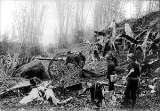
to gain independence following annexation by the United States. The war was part of a series of conflicts in the Philippine struggle for independence
, preceded by the Philippine Revolution
and the Spanish–American War.
Fighting erupted between U.S.
"for American energy to build up such a commercial marine on the Pacific Coast as should ultimately convert the Pacific Ocean into an American lake, making it far more our own than the Atlantic Ocean is now Great Britain's"--Whitelaw Reid|Whitelaw Reid, part of the commision sent to Paris to negotiate the Treaty of Paris|Treaty of Paris to end the Spanish-American War|Spanish-American War.
![]()
"The fighting ... was precipitated by ... two native soldiers who refused to obey the order of a sentry who challenged their passage to his post.... They insolently refused to [halt] and continued to advance," so the sentry shot them.
![]()
The U.S. troops were "expecting trouble and were glad to have an opportunity to square accounts with the natives, whose insolence of late was becoming intolerable."
![]()
"The slaughter at Manila was necessary, but not glorious. The entire American population justifies the conduct of its army at Manila because only by a crushing repulse of the Filipinos could our position be made secure....We are... the trustees of civilization and peace throughout the islands"...the "white man's burden" had been thrust on the United States by "the impotent oppression of Spain and the semi-barbarous conduct of the Philippines."
![]()
Major Edwin Glenn|Edwin Glenn did not deny that he made forty-seven prisoners kneel and "repent of their sins" before ordering them bayoneted and clubbed to death.
![]()
"Obtain information from natives no matter what measures have to be adopted."--Adna Chaffee|General Adna Chaffee
![]()

